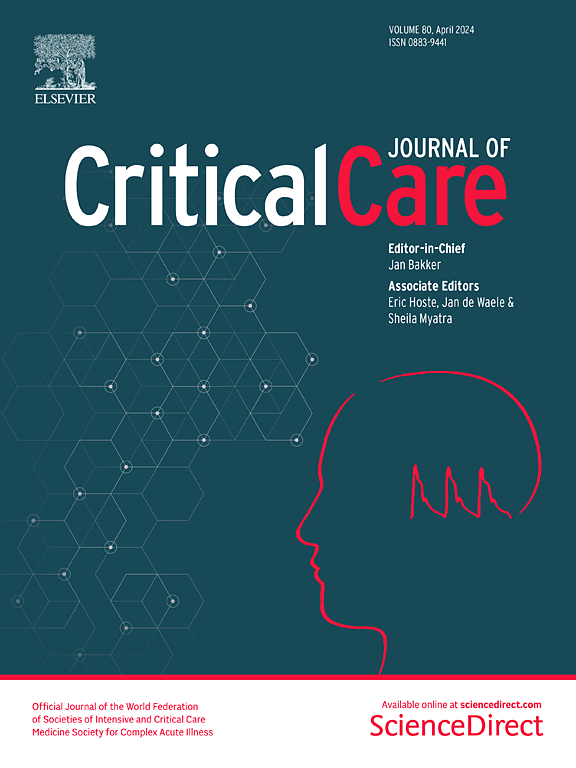Predictors of weaning failure in ventilated intensive care patients: a systematic evidence map
IF 8.8
1区 医学
Q1 CRITICAL CARE MEDICINE
引用次数: 0
Abstract
Ventilator weaning is of great importance for intensive care patients in order to avoid complications caused by prolonged ventilation. However, not all patients succeed in weaning immediately. Their spontaneous breathing may be insufficient, resulting in extubation failure and the subsequent need for reintubation. To identify patients at high risk for weaning failure, a variety of potential predictors has already been examined in individual studies and meta-analyses over the last decades. However, an overview of all the predictors investigated is missing. To provide an overview of empirically investigated predictors for weaning failure. A systematic evidence map was developed. To this end, we conducted a systematic search in the Medline, Cochrane, and CINAHL databases in December 2023 and added a citation search and a manual search in June 2024. Studies on predictors for weaning failure in adults ventilated in the intensive care unit were included. Studies on children, outpatients, non-invasive ventilation, or explanatory factors of weaning failure were excluded. Two reviewers performed the screening and data extraction independently. Data synthesis followed an inductive approach in which the predictors were thematically analyzed, sorted, and clustered. Of the 1388 records obtained, 140 studies were included in the analysis. The 112 prospective and 28 retrospective studies investigated a total of 145 predictors. These were assigned to the four central clusters ‘Imaging procedures’ (n = 22), ‘Physiological parameters’ (n = 61), ‘Scores and indices’ (n = 53), and ‘Machine learning models’ (n = 9). The most frequently investigated predictors are the rapid shallow breathing index, the diaphragm thickening fraction, the respiratory rate, the P/F ratio, and the diaphragm excursion. Predictors for weaning failure are widely researched. To date, 145 predictors have been investigated with varying intensity in 140 studies that are in line with the current weaning definition. It is no longer just individual predictors that are investigated, but more comprehensive assessments, indices and machine learning models in the last decade. Future research should be conducted in line with international weaning definitions and further investigate poorly researched predictors. Registration, Protocol: https://doi.org/10.17605/OSF.IO/2KDYU呼吸机重症监护患者断奶失败的预测因素:系统证据图谱
呼吸机断气对重症监护患者非常重要,可避免因长期通气引起并发症。然而,并非所有患者都能立即成功断气。他们的自主呼吸可能不足,导致拔管失败,随后需要重新插管。为了识别断流失败的高风险患者,过去几十年来,已有多项研究和荟萃分析对各种潜在的预测因素进行了研究。然而,目前还缺少对所有预测因素的综述。为了对断奶失败的实证调查预测因素进行概述,我们绘制了一张系统的证据图。我们绘制了一张系统证据图。为此,我们于 2023 年 12 月在 Medline、Cochrane 和 CINAHL 数据库中进行了系统检索,并于 2024 年 6 月增加了引文检索和人工检索。我们纳入了有关重症监护室成人断奶失败预测因素的研究。排除了有关儿童、门诊患者、无创通气或断奶失败解释因素的研究。两名审稿人独立完成了筛选和数据提取工作。数据综合采用归纳法,对预测因素进行主题分析、分类和聚类。在获得的 1388 条记录中,有 140 项研究被纳入分析。112 项前瞻性研究和 28 项回顾性研究共调查了 145 项预测因素。这些预测因子被归入四个中心分组:"成像程序"(22 项)、"生理参数"(61 项)、"评分和指数"(53 项)和 "机器学习模型"(9 项)。最常用的预测指标是快速浅呼吸指数、膈肌增厚分数、呼吸频率、P/F 比值和膈肌偏移。对断奶失败的预测因素进行了广泛研究。迄今为止,已有 140 项符合当前断奶定义的研究对 145 种预测因素进行了不同程度的调查。近十年来,研究的不再仅仅是单个预测因子,而是更全面的评估、指数和机器学习模型。未来的研究应与国际断奶定义保持一致,并进一步调查研究不足的预测因素。注册,协议: https://doi.org/10.17605/OSF.IO/2KDYU
本文章由计算机程序翻译,如有差异,请以英文原文为准。
求助全文
约1分钟内获得全文
求助全文
来源期刊

Critical Care
医学-危重病医学
CiteScore
20.60
自引率
3.30%
发文量
348
审稿时长
1.5 months
期刊介绍:
Critical Care is an esteemed international medical journal that undergoes a rigorous peer-review process to maintain its high quality standards. Its primary objective is to enhance the healthcare services offered to critically ill patients. To achieve this, the journal focuses on gathering, exchanging, disseminating, and endorsing evidence-based information that is highly relevant to intensivists. By doing so, Critical Care seeks to provide a thorough and inclusive examination of the intensive care field.
 求助内容:
求助内容: 应助结果提醒方式:
应助结果提醒方式:


